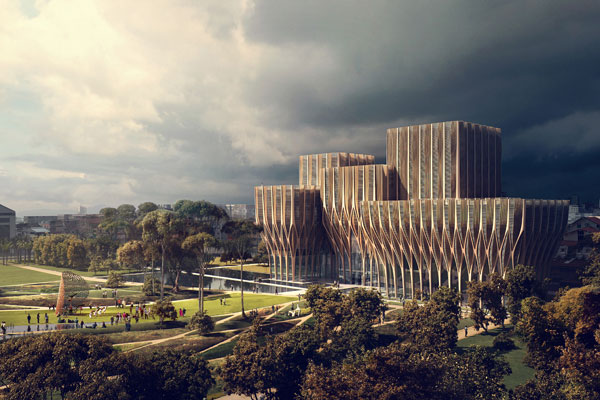An architect well known for her signature curvy exoskeletal structures and sleek sweeping lines, Zaha Hadid tones down her approach to reveal a restrained and quietly elegant design for the new Sleuk Rith Institute, a genocide museum and research facility in Cambodia, writes Olha Romaniuk.

October 27th, 2014
The extensive and intelligent design brief for the Sleuk Rith Institute stemmed out of the vision of Youk Chhang, a human rights activist and survivor of the Khmer Rouge regime under which two million Cambodians lost their lives. Instead of asking for a stern and solemn design typically associated with genocide memorial architecture, Chhang delineated a brief that put an emphasis on reflection and reconciliation in the face of the tragedies of the past and veered its focus toward a more positive future of Cambodia. “We were keen to create a forward-looking institution that deviated from the distress-invoking, quasi-industrial harshness of most existing genocide memorial models,” says Chhang.
Zaha Hadid’s design addresses the brief’s concerns by unveiling a building that is as visually impactful as it is respectful to the content and context of the heavily-loaded subject and site without becoming a sombre monument oriented towards memories of the past. The design, reminiscent of Hadid’s typical architectural forms in only the faintest of ways through the restrained, fluid lines of the exterior structure, presents a series of soaring forms that set a warm, light tone that is anything but melancholic or mournful.
The contemporary vision for the Sleuk Rith Institute comprises five buildings that serve different functions at the lower levels and merge together to create collaborative research spaces as the structure ascends to the top. The interweaving forms draw inspiration from the architecture of Angkor Wat and other Cambodian temples, combining a multitude of geometric forms to create a cohesive whole. “We were inspired by how the ancient temples make very intricate forms from simple geometries,” says DaeWha Kang, project architect for the Institute.
Heavily inspired by the surrounding context of the site and the tropical climate of Cambodia, the design of the Sleuk Rith Institute marks a unique approach by Hadid’s office to make this project as contextually relevant as it is content driven. “This is very different to our other projects,” says Hadid. “It is the first time we have used wood to create a warmer, softer mood, and in time it will weather and take on a more a natural-looking feel.” The sustainably-sourced wood is also the choice for exterior shading to reduce the overall solar gain. The tapering forms of the buildings are composed in an exacting way to minimise solar gain while thermal buffer zones protect the interior exhibition and archival spaces.
While the buildings are propped on raised terraces for protection from the seasonal flooding from the Mekong and Tonlé Sap rivers, the surrounding reflective pools are replenished with harvested rainwater to minimise the overall environmental impact. Thoughtful treatment of water condensation and foul water is evident in the inclusion of a natural plant-based water treatment system and on-site bioreactors, while a solar thermal array to generate hot water is tucked away from public view on the building’s horizontal roof along with other renewable energy equipment.
With the design of the Institute’s buildings in tune with the content and context of the site, the Institute’s site also includes a 68,000 square metre community park that will further protect against seasonal flooding and provide linkages between the site’s neighbouring streets, inviting the community to experience the Institute as a space for public reflection and commemoration. “Our hope is that the Sleuk Rith Institute and its Memorial Park can have a truly transformative effect, bringing new life and a bright future to a site that holds traces of the great tragedies of the past. An inviting place where reflection, interaction and connectivity are not only its spatial expression, but also embedded within its covenant to the people of Cambodia,” says Hadid.
Zaha Hadid Architects
zaha-hadid.com
A searchable and comprehensive guide for specifying leading products and their suppliers
Keep up to date with the latest and greatest from our industry BFF's!

Create a configuration to suit your needs with this curved collection.

Suitable for applications ranging from schools and retail outlets to computer rooms and X-ray suites, Palettone comes in two varieties and a choice of more than fifty colours.

Savage Design’s approach to understanding the relationship between design concepts and user experience, particularly with metalwork, transcends traditional boundaries, blending timeless craftsmanship with digital innovation to create enduring elegance in objects, furnishings, and door furniture.

Marylou Cafaro’s first trendjournal sparked a powerful, decades-long movement in joinery designs and finishes which eventually saw Australian design develop its independence and characteristic style. Now, polytec offers all-new insights into the future of Australian design.
The internet never sleeps! Here's the stuff you might have missed

Milanese artisan Henry Timi celebrates natural materials through strikingly reduced geometric forms, creating a stripped-back vision of interior luxury.

Simon Liley, Principal Sustainability Consultant at Cundall, writes about how cyberpunk dystopias haven’t (quite) come to pass yet – and how designers can avoid them.